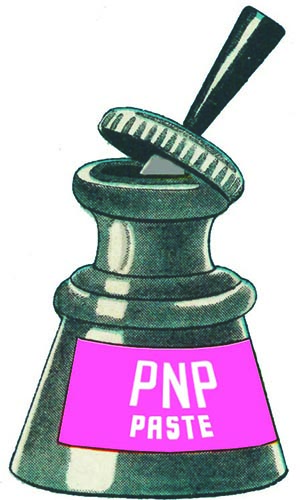If you coin or transmit neologisms for public controversies ending in the syllable '-gate', you are an enemy of humanity. I will attempt to convince you of this proposition by means of four arguments: stylistic, humanistic, ethical and spiritual.
STYLISTIC
There are three justifications for wordplay: that it satisfies the audience's aesthetic sense by being funny or beautiful, that it satisfies the reader's intellect by being witty or insightful, or that it satisfies the wordplayer's sadism by the infliction of that particular form of psychic distress which causes people to groan at atrocious puns. -GATE coinages fulfil none of these criteria. The original Watergate scandal took its name from the office complex where Republican operatives attempted to wiretap the Democratic National Committee headquarters in 1972: the syllable 'gate' has no semantic connection with this affair, and the hundreds of subsequent -GATE coinages are neither funny nor wince-inducingly awful. Instead, they evoke a stale and shallow weariness reminiscent of the third hour of a high-school speech night, or a long Sunday afternoon when no snacks are available.
HUMANISTIC
In the face of the increasing deployment of drones, algorithmically targeted advertisements and other forms of seemingly autonomous behaviour by computers, it has become a commonplace to express facetious alarm at the impending prospect of a robotic uprising and the subsequent extinction or enslavement of the human race. However, true artificial intelligence is still a distant goal, and we have no way of knowing what it will be like. The mind of the imaginary robot, then, is simply a human intelligence (this being the only kind with which we are familiar) with those features which we view as being essentially human removed: the capacity to feel emotions, to think creatively, to laugh, love or dream, and so on. We fear such beings because we are aware of what we ourselves might become if we were reduced to unreflective automata. I hold that the formation of -GATE clichés is a minor example of such an automatism: like all clichés, it is terrible not only because it is dull, but because in it, we see our humanity reduced to the banal repetition of meaningless syllables. If you fear the robot, seek out and destroy it within thyself.
ETHICAL
The use of the -GATE suffix to describe any scandal was first popularised by the conservative columnist and former Nixon speechwriter William Safire: he was personally responsible for more than twenty such coinages. In later years, Safire confessed that this might have been an unconscious attempt to trivialise the crimes committed by his former employer. More generally, we may observe that the use of -GATE to describe a scandal is an unfailing signal that the affair in question, if it were serious in the first place, has become trivialised and will not be properly resolved. The -GATE formation may be compared to the secretion with which a bivalve surrounds and entombs an irritant: like almost all natural pearls, it is ugly and without value except as a defense mechanism.
SPIRITUAL
The faculty of language separates humanity from all other animal species, and many cultural traditions have not hesitated to assert that it is a divine gift. Whatever its origins, the fact that the squawking and grunting of upright apes can express anything of value at all is a miracle: when we succumb to such useless chatter as -GATE coinages, we debase not only ourselves, but the instrument through which all human culture is sustained and passed on to posterity.
MIKE LYNCH, SYDNEY
For some minutes she hesitated at the gate but made the wise decision not to go there and thus humanity was saved from facile cliché. Wood engraving, 1887, State Library of Victoria IAN21/12/87/supp/11 . Available at http://handle.slv.vic.gov.au/10381/253494.


